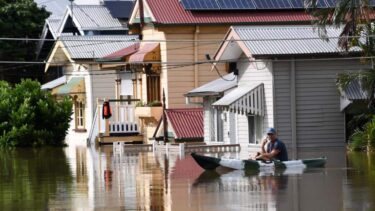Share this article
The Intergovernmental Panel on Climate Change’s Sixth Assessment Report; Impacts Adaptation and Vulnerability was released late February this year. In the same week, over 23,000 homes were affected by a major flooding event in Brisbane, an event undeniably exacerbated by climate change.
Although my work as a Principal Consultant at Anthesis centres around mitigating the causes of climate change, mitigation is only part of the picture. Regardless of how fast we manage to reduce emissions and curb climate change, adaptation is already a necessity to build resilience as disaster events are anticipated to grow in frequency and duration.
Climate predictions for Southeast Queensland suggest we can expect more intense downpours, harsher fire weather, and reduced rainfall. These are all hazards which land very close to home, given the recent flooding was caused by significant intense rainfall, and the 2019 bushfires remain a not-too-distant memory.
Reflecting on these recent events, observations made during the floods, and through my professional and academic experience – I contemplate how much we have already learnt about adaptation and some of the gaps in becoming resilient populations going forward.
Disaster Risk Reduction Principles – There is No Such Thing as a Natural Disaster

Disaster Risk Reduction principles state there is no such thing as a natural disaster. Storms, earthquakes, droughts are all natural, yes, – but they are natural hazards, not disasters.
Disasters are events which cause significant impacts that cause serious disruption to the functioning of society because of a hazard. The disaster strikes when the hazard comes into contact with vulnerable human systems. The severity of a disaster comes down to how resilient the communities and ecosystems are, as well as the severity of the hazard.
In the recent floods in Brisbane and Northern NSW, a lot of the dialogue focussed on the hazard and the “unprecedented” amounts of rain. For more constructive adaptation, this needs to shift and we need to have conversations about the vulnerability and resilience of communities.
Learning Through Disasters and Building Disaster Resilience
The disaster management cycle is just that – a cycle. And this presents an opportunity to learn from past disasters, and apply them to what lies ahead. This can happen at any of the four stages of the cycle – Response, Recovery, Mitigation and Preparation.
Given Brisbane has just passed through a recent Response phase and the Recovery phase is still underway, I reflect on learnings that were integrated during the recent floods in Brisbane in these phases and how they support building disaster resilience.
Response: Clear Communication for Effective Response
During any event, including the flooding in Brisbane, one of the most critical things is access to information; information on the status of the disaster, what to expect, and guidance on how to respond.
Even before the water broke the banks of the Brisbane River, social media was abuzz with links to a whole range of resources and communications. Across the weekend of the flood, there were flood prediction maps, electricity outage maps, aerial footage of the river, graphs of water meters at different rivers and countless videos and Facebook posts summarising resources available. Local councillors and state MPs took to social media, providing videos of their communities, showing where water levels had risen to, and a visual so individuals did not have to leave home to see it themselves. And the communication came in different forms – they hosted community meetings in person and online, went door knocking, Facebook, Instagram, emails, news blogs and daily press conferences.
Clear messaging supported individuals to know how to respond. Transparency builds trust, which increases coordination in response. What this means for businesses and councils is – prepare with a communication plan, and embrace un-polished, open, and transparent communication with staff and the community.

Recovery: Community Based Action
Given the extent of the damage organised (SES/QFES), formal (Mud Army) and informal (through social networks) initiatives popped up to support the recovery efforts.
Mud Army Volunteers came out in force in 2011 to take out damaged furniture, hose down floors and walls and sweep out thick mud. This year registrations came in thick and fast again, with over 10,000 registrations in the three days after the waters rose.
However, much quicker than the formal Mud Army was the emergence of local groups and neighbours helping neighbours, emphasising the importance of community networks, and demonstrating that the community remembers and knows how to respond.
And this time the informal recovery efforts were much more informed – social media accounts shared lessons learnt about how to take a sensitive and respectful approach to supporting the clean-up. Advice included practical recommendations which reduced the stress of those impacted, ensured recoverable possessions were not thrown out, and that action to support insurance claims was undertaken.
One thing we know for sure – community is central to resilience. The Australian Natural Disaster Resilience index makes that apparent. Clearly the learning and increased capacity of the community played a huge role in recovery efforts this time around.
Disaster Resilience – How to be Better Prepared
While some lessons have been learnt, it’s evident that there is much more to be done to reduce the impact of disasters and in adapting to a world with more frequent disasters. When building disaster resilience:
- Both individuals and businesses should know their exposure and be familiar with local and regional disaster management plans and hazards (an example for Brisbane here) and council disaster preparedness resources.
- Plan to reduce the impacts of disasters – great resources exist to support planning and response in the event of a disaster, for Community Organisations (see this template from Resilient Community Organisations) or implement a Disaster Risk Reduction plan for your organisation or area.
- Businesses should also understand and disclose climate related risks – see the Task Force on Climate-related Financial Disclosures disclosure recommendations. The more companies that follow these recommendations the more transparent financial markets will be with respect to climate impacts, to support informed, efficient capital allocation decisions.
- And finally, create an emissions reduction plan for your organisation and strive for a science-based net zero target to support limiting global warming to below dangerous thresholds. Everything we do now can help with reducing the long-term impacts of climate change on the world and its people.
As the wet weather continues in the northern states and we know extreme weather events will be a more regular occurrence in the coming years, focusing not only on climate change mitigation but also adaptation will be key to building disaster resilient communities of the future.
We work with organisations to support them in mitigating and adapting to the effects and risks of climate change. To learn more reach out to the team by mail or, give us a Call +61 3 7035 1740, we’d love to help.
Main image: Brisbane Flood. Credit Darren England-AAP

